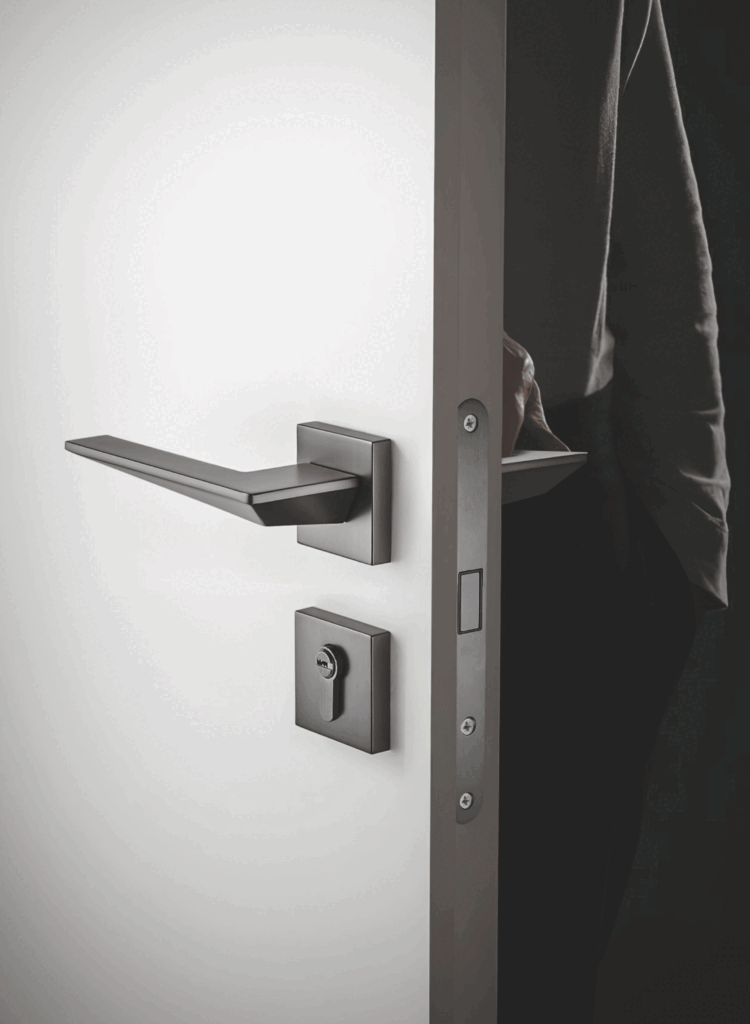Introduction
In the world of door security, not all locks are created equal. For anyone involved in choosing or selling door hardware—whether you’re a door manufacturer, importer, or hardware supermarket buyer—understanding the differences between lock types is essential. The most commonly used lock types are deadbolts and latches, and each offers distinct advantages.
In this extended guide, we’ll walk you through how they work, what makes them different, and how to choose the best one for your projects—whether you’re outfitting hundreds of apartment doors or stocking products for end customers.
What Is a Deadbolt?
A deadbolt is a high-security locking mechanism designed to resist forced entry. It operates without a spring and cannot be moved unless turned manually by a key or thumbturn. That’s why deadbolts are often used on exterior doors and other high-security areas.
How It Works
The core of a deadbolt is a solid, heavy-duty bolt made of steel or brass. When the lock is engaged, the bolt slides deep into a strike plate on the door frame. Unlike spring latches, the bolt cannot retract unless you turn the key or the inside knob.
Key Features:
- No spring mechanism, which means no accidental retraction.
- Operates via key or thumbturn, making unauthorized access more difficult.
- Built-in strength that withstands kicking, prying, and lock picking.
Typical Applications:
- Main entrances of homes and apartments.
- Commercial property access doors.
- Utility rooms or private offices needing extra protection.
Deadbolts are commonly used in SUZHOU UMAY’s mechanical lock range, especially in our high-security exterior lock sets.
What Is a Latch?
A latch is a basic spring-loaded lock mechanism found in most door handles and knob sets. It’s designed for convenience over security. When the door is pushed or pulled, the latch retracts automatically.
How It Works
The latch uses a beveled bolt held in place by a spring. When the door closes, the bolt slips into the strike plate. Turning the handle or knob compresses the spring and pulls the bolt back in.
Key Features:
- Fast operation—just turn the handle to enter or exit.
- Spring tension keeps the bolt in place when the door is closed.
- Often combined with other locking mechanisms in handle sets.
Typical Applications:
- Interior doors in homes or offices.
- Closet doors and storage cabinets.
Doors where frequent access is more important than high security.
Deadbolt vs Latch: A Detailed Comparison
Let’s explore the core differences that affect usability, cost, and security.
1. Security Performance
- Deadbolts are far more secure. Their solid bolt resists brute-force attacks, crowbars, and lockpicks.
- Latches are easy to bypass using a thin tool (like a card or screwdriver), especially when not paired with a secondary lock.
2. Durability
- Deadbolts are made for long-term use and perform well under tough conditions.
- Latches wear out more quickly due to their spring components, especially on high-traffic doors.
3. Ease of Use
- Deadbolts require a conscious action (key or thumbturn). This is more secure, but slower.
- Latches are user-friendly, perfect for kids and elderly users in interior applications.
4. Installation Complexity
- Installing a deadbolt means precise drilling, correct strike plate alignment, and potentially reinforcing the door frame.
- Latches are usually pre-installed in knob or lever sets and can be installed by most DIY users.
5. Cost Consideration
- Deadbolts are more expensive because of their materials and construction.
- Latches are economical and ideal for large-volume interior use.
Tip: Combine both in one set—use a deadbolt for outer security and a latch for daily function.
Choosing the Right Lock for Commercial or Residential Projects
At SUZHOU UMAY, we work with clients from a wide range of industries. Here’s what we usually recommend based on door application:
For Door Manufacturers:
Offer combo sets—deadbolt plus latch handles—for main entrances. It adds value and increases perceived product quality.
For Regional Hardware Brands:
Stock both deadbolts and latches, with customizable finishes like matte black, satin nickel, and antique brass. This appeals to style-conscious buyers.
For Supermarket Procurement Managers:
Ensure your product line covers all needs—deadbolts for entry points, latches for room doors, and even door closers, peepholes, and hinges for bundled sales.
Share This Story, Choose Your Platform!

